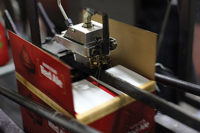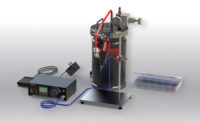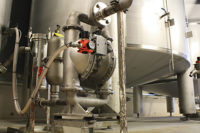Double-Down on Case Sealing Success
Folding the tape edge enhances reliability, productivity and safety.

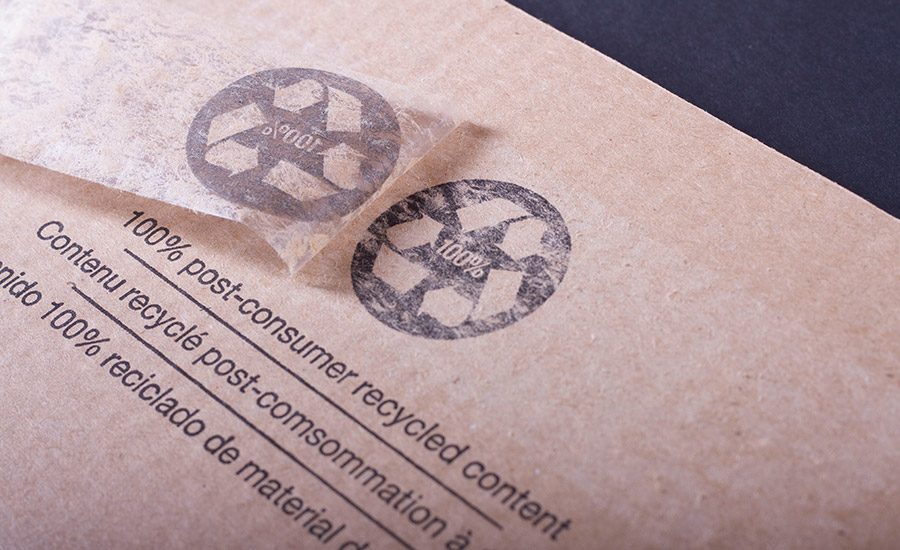
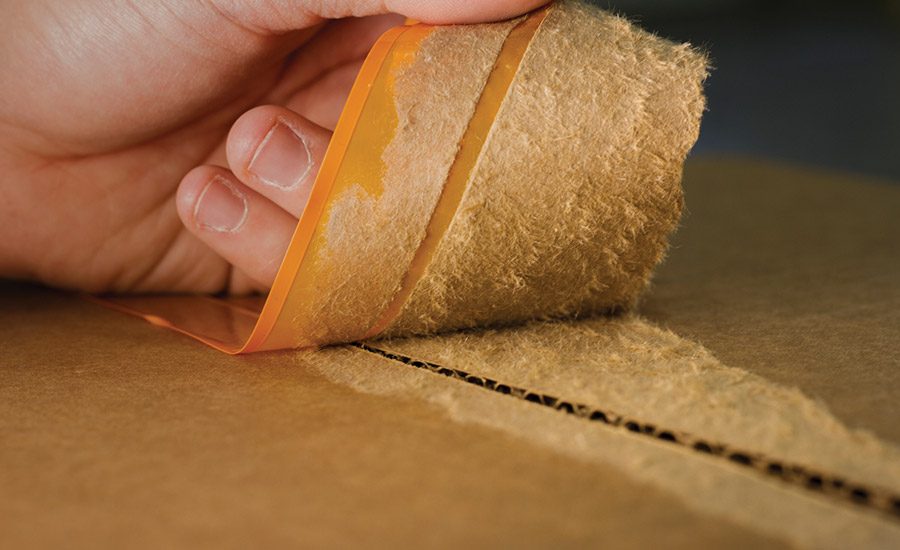


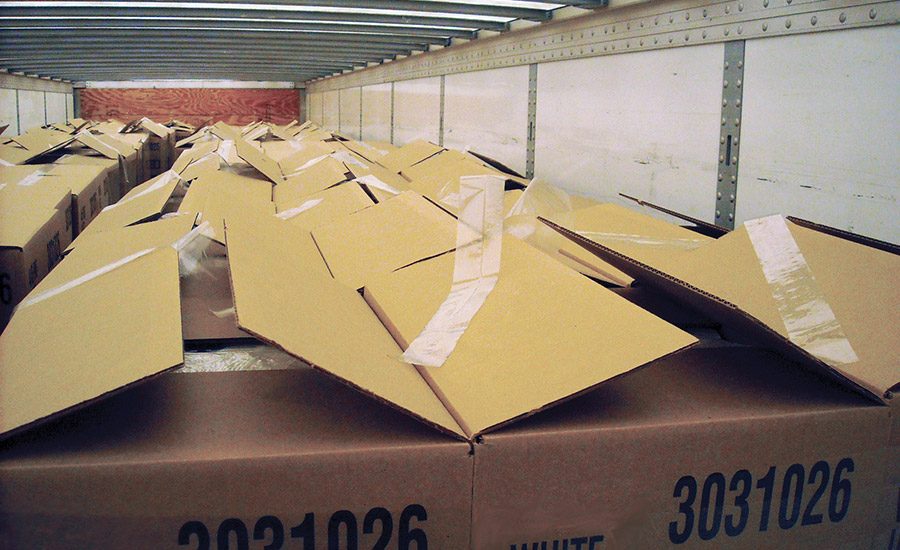






Manual labor, for example, is still used by some manufacturers for tasks like picking and packing. Others have moved to automation for everything from case forming and packing to sealing and palletizing in an effort to improve the efficiency of their operation by enhancing uptime, reducing labor costs, and minimizing material waste.
Case taping and sealing is a small but critical function of the overall end-of-line system. Different application techniques can enhance the reliability of the seal, the productivity of the line and the safety of those opening the cartons.
Case Taping
In theory, the case sealing process is simple: cartons go in, tape is applied, and sealed cartons are palletized for transport or storage. In reality, however, application of packaging tape isn’t necessarily an exact science; it’s a delicate balance between the packaging machine, tape applicator and packaging tape, which must work together to ensure cartons are closed securely to keep the products inside safe.
Many factors can impact the tape’s ability to remain adhered to the carton. Environmental conditions such as dust, dirt, humidity and cold temperatures can contribute to the performance of packaging tape, as can characteristics of the surface to which it’s being applied. Recycled cartons, for example, contain smaller fibers and fillers that can make it hard for packaging tape to stick; thus, sealing in these situations may require the use of a specialized packaging tape. Other factors that can impact the reliability of the seal include tension from a misadjusted tape head, stress from a high-speed operation or even poor unwind characteristics built into the packaging tape. These issues can lead to tape stretch or breakage, negatively impacting the quality and reliability of the seal, as well as the uptime of the line.
Tape Stretch
Think about a rubber band. It’s stretched to wrap around items to bind them together, but, when removed, has a natural tendency to return to its original shape and size. Due to its polypropylene backing, which has elastic-like qualities, packaging tape is not unlike a rubber band. Tape is unwound from the roll and applied to the carton surface to seal the flaps; if stretched, however, it has a desire to relax. This is intensified should the tape be overstretched during application, which places unnecessary stress on the seal. With the added stress on the adhesive, the tape is subject to pop and the carton to open, leaving product exposed or forcing costly reworks.
In many cases of overstretching, excessive tension is the cause. This is often the result when a tape applicator’s tensioning is adjusted too tightly, in high-speed operations where additional unwind force is placed on the tape, or when tapes with poor unwind characteristics are used.
Tape failures due to stretch, such as flagging and lifting, are also prevalent with acrylic tapes due to the viscosity or liquid-like state of the adhesive that makes it capable of flowing out when stress forces are met and in operations in which the tape applicator is not providing sufficient wipe-down pressure as the tape is applied. Because packaging tapes are pressure sensitive, they require some type of force to create a bond to the carton. The proper amount of pressure drives the tape’s adhesive into the surface, allowing it to entangle itself deep within the fibers of the carton; without this pressure, the adhesive may not fully engage with the carton surface, increasing the possibility of it releasing under stress.
Microscopic Nicks
Another issue that can affect the end-of-line case sealing process is tape breakage. Typically occurring within the automated tape head as the tape goes around the rollers, these tear-outs can lead to missed seals, machine or line downtime, and material waste.
During the manufacturing process, microscopic nicks are inherently created in the edges of the tape. These may be stressed to the point of fracture when paired with high tension from a poorly adjusted tape head, high-speed operation or high-force unwind from the packaging tape roll.
Folding Tape Edges
Case sealing technology has come a long way, with new innovations allowing for faster tape application, tab length adjustments, quick and easy tape roll changeovers, and even the ability to fold the edge of the tape as it’s applied. Folding the tape edge makes both the tape and seal more forgiving, allowing more room for errors in equipment adjustments, as well as adding strength to the tape to accommodate variations.
Folding the edges of the tape as it’s applied essentially kisses the adhesive together to produce an edge that’s double the thickness of the tape. This creates a more uniform, stronger tape edge, enhancing the reliability of the seal, the productivity of the case sealing process and the safety of tape removal for those unpacking the carton contents. Hence, folding the edges of the tape can address and eliminate potential issues as tape is applied, resulting in better consistency and productivity in the case sealing process, as well as stronger, more reliable case seals.
Increases Reliability
The expectation of the case seal is that it will withstand the rigors of the distribution network to ensure contents are delivered intact. The folded edge on the tape increases the seal’s strength, particularly at the most vulnerable failure point the edges where the major flaps meet the side of the carton. The additional strength reduces the risk of the tape being nicked and broken, providing an added layer of security to keep contents secure from damage, contamination and theft.
In some cases, folding the edge even creates the ability for manufacturers to down gauge tape grades. Packaging tapes are available in a variety of grades, which ensure the right holding power and tensile strength for the case seal. Tape grade is selected based on several factors, including the carton’s size and weight, value of the contents inside, and production/shipping environment.
Increases Productivity
As noted earlier, tension placed on the tape during application can lead to inefficiencies such as downtime, reworks and material waste. That stress intensifies with poorly adjusted equipment, as the speed of the line increases, or even as the size of the roll decreases. With a folded edge, the tape is able to handle more stress, allowing it to process faster and better.
Keep in mind that tape stretch may cause issues during processing as well, especially in situations in which overstretching has occurred during application. The tendency for the tape to revert to its original shape can force the adhesive to pull away from the carton’s surface. But, by doubling the thickness of the tape edge, the potential for stretch is reduced, meaning less stress on the adhesive and less risk of flagging or lifting. In addition, tiny microscopic nicks created by the manufacturing process are eliminated, resulting in more uptime, fewer breakouts and less material waste.
Increases Safety
Folding the tape edge may even benefit case recipients. If not careful, the most common ways to open a box (e.g., using a knife, box cutter or other sharp instrument) can yield unforeseen damage and harm.
One unfortunate result of using a sharp instrument to open cartons is product damage. Once a product’s packaging is compromised, it is likely to be considered unsaleable. In fact, the Grocery Manufacturers Association and Food Marketing Institute estimate that damaged product and other unsalable items cost consumer packaged goods manufacturers $15 billion annually 1-2% of a manufacturer’s gross sales. Returns are such a common practice in business that many retailers and manufacturers have agreed-upon return and/or damage allowances built into purchase orders to cover anticipated loss.
A second unfortunate result of using a knife during the unpacking process is personal injury due to cuts and lacerations. The costs associated with those injuries can be high. The Occupational Safety and Health Administration (OSHA) suggests that direct (workers’ compensation payouts, healthcare) and indirect (wages paid to injured workers, lost time, time and money spent on worker replacement) costs related to a cut or laceration can be upwards of $35,000. With such high costs associated with using a knife, eliminating it from the equation is a welcome preventative measure. By folding the edges of the tape as it’s applied, a secure, easy-to-open carton seal is created one that doesn’t require a knife or other sharp instrument to open. Instead, there’s a dry edge that allows the tape to be removed by hand, reducing the risk of product damage and worker injury along the supply chain.
Folding over the tape is a simple solution with countless benefits. It protects products by delivering a strong and reliable case seal capable of withstanding the distribution network, profits by helping to keep the packaging line running at peak production, and people through an easy-to-open seal that doesn’t require a knife. ASI
For more information, visit www.shurtape.com.
Looking for a reprint of this article?
From high-res PDFs to custom plaques, order your copy today!



